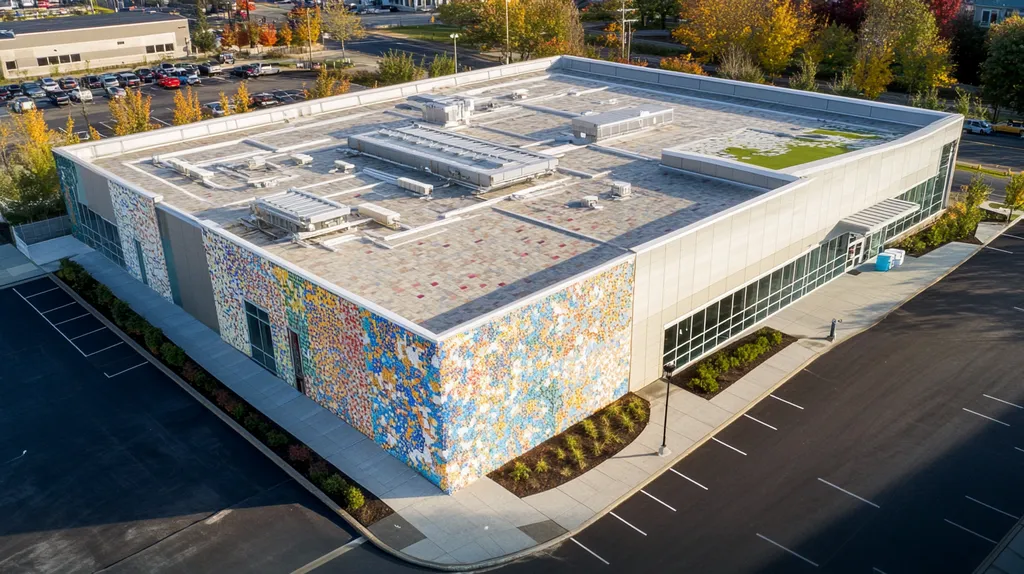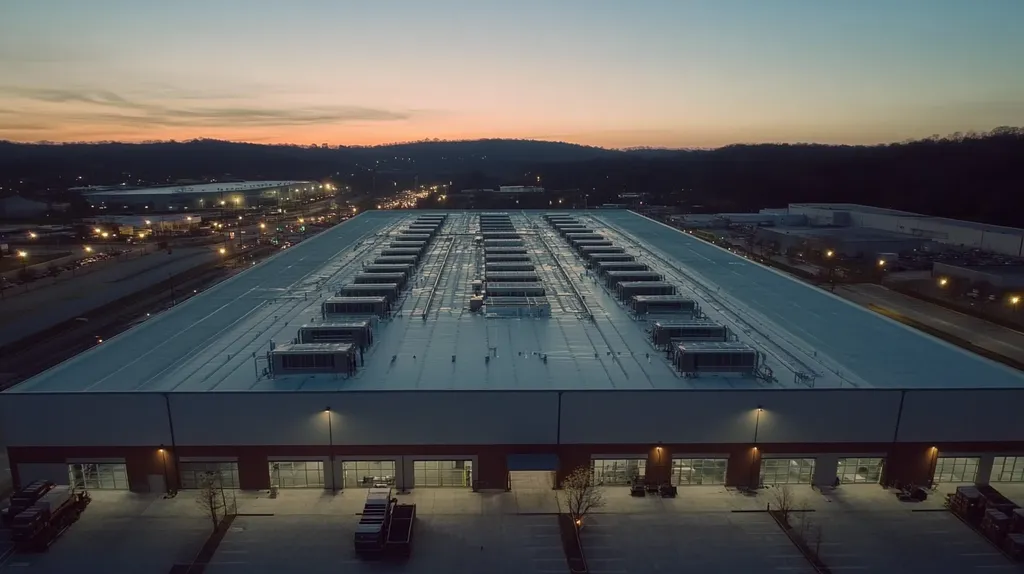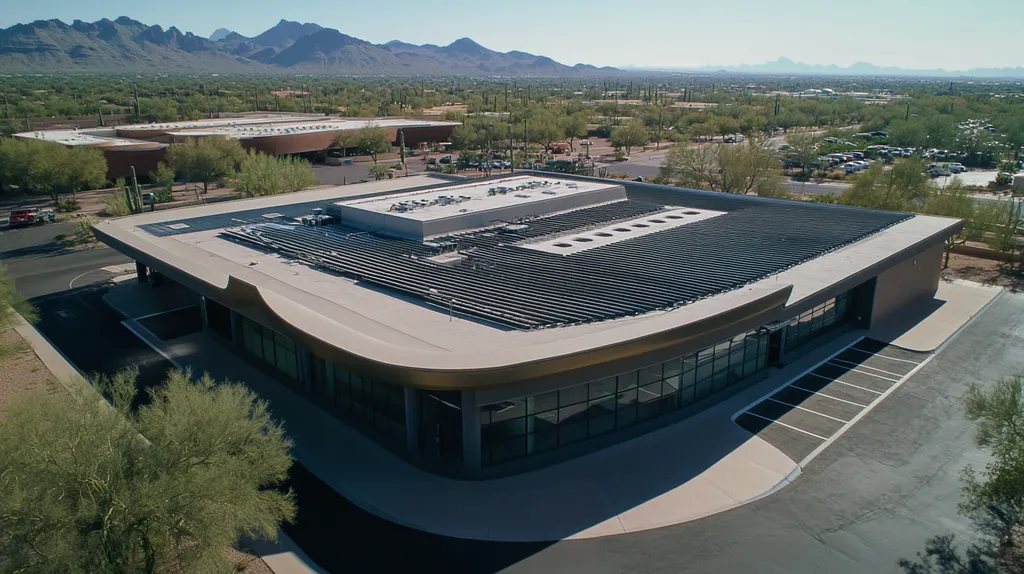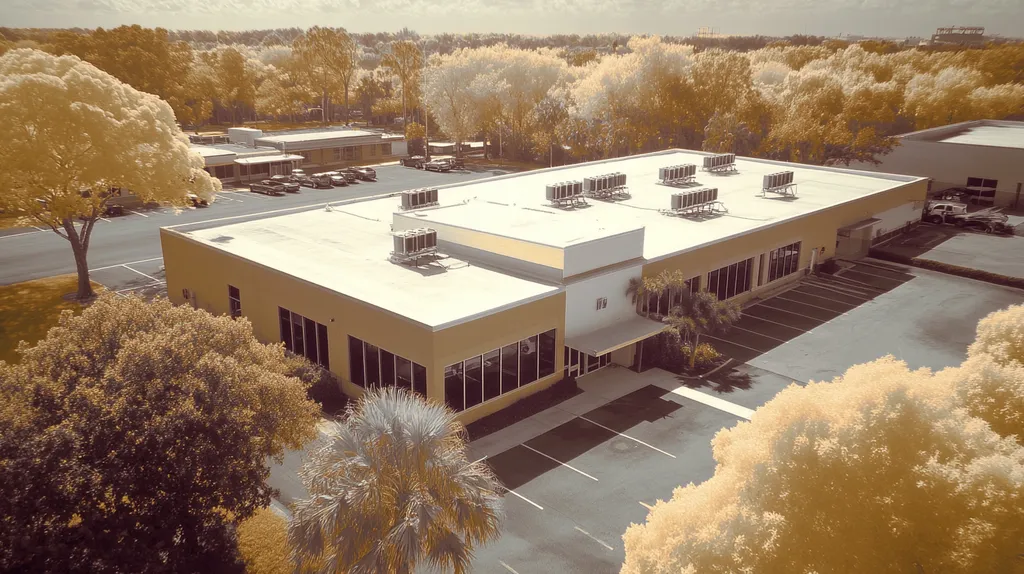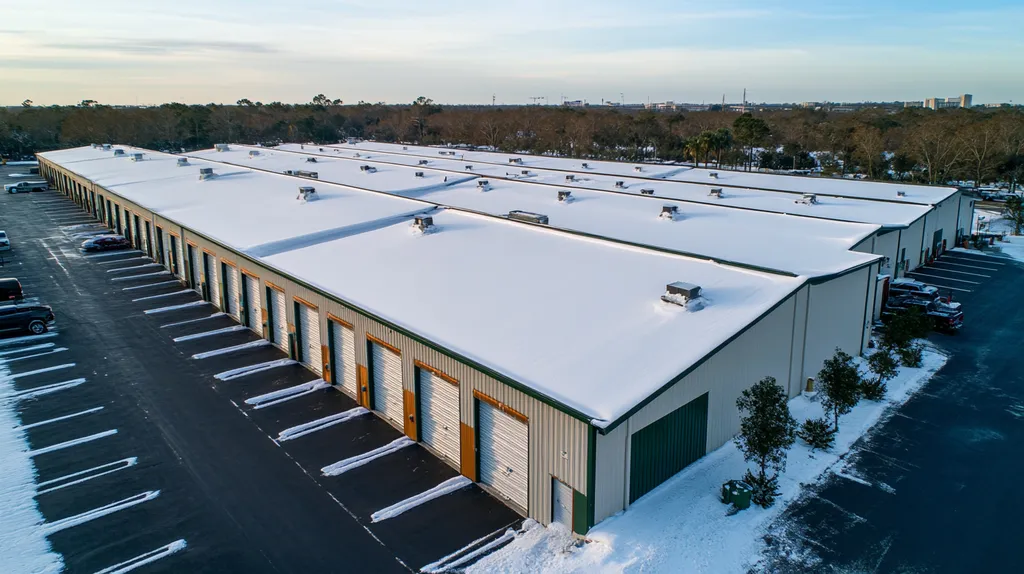Commercial property managers face mounting challenges with roof drainage and coating failures, with industry data showing over $2.5 billion spent annually on preventable water damage repairs.
Widespread misconceptions about roof coatings continue to drive poor decision-making, leading to premature system failures and skyrocketing maintenance costs.
This comprehensive analysis examines critical coating myths, their practical implications, and evidence-based solutions that can extend roof lifespans while reducing long-term expenses.
By understanding the realities of commercial roof coatings and drainage systems, property managers can make informed decisions that protect their investments and avoid costly remediation.
SECTION 1: COMMON MISCONCEPTIONS
Misunderstandings about commercial roof coatings can lead to financial setbacks for property managers. For instance, the misconception that roof coatings are just a temporary fix often results in severe water damage and a weakened building structure. Moreover, failing to recognize that various roof types need specific solutions can worsen drainage problems. Addressing these misconceptions is essential for making educated decisions regarding roof maintenance and coating applications.
Roof Coatings Are Ineffective
A common misconception is that roof coatings deliver no real benefits. In fact, high-quality coatings can significantly enhance roof durability, reduce energy costs, and extend the overall lifespan of a roof. Industry studies show that reflective roof coatings can cut cooling expenses by as much as 30% in warmer climates.
Additionally, effective roof coatings create a seamless barrier that guards against leaks and UV exposure. Buildings located in regions with heavy rainfall can suffer from substantial water intrusion if inappropriate coatings are chosen. Clearing up this misconception is vital for property managers aiming to safeguard their roofing investments.
It is also misleading to assume that all roof coatings have the same performance. Various products are specifically formulated for different roofing materials and climatic conditions, making informed selection critical for property managers.
Overlooking the potential benefits of roof coatings can lead to missed opportunities for cost savings and enhanced property value. A better understanding of effective coatings can reshape building maintenance strategies.
Silicone Coatings Are Completely Waterproof
Another prevalent myth is that silicone coatings provide 100% waterproof protection. While silicone is an outstanding water-resistant choice, it is not a solution for every roofing concern. Proper application and regular maintenance are necessary to optimize the benefits of silicone coatings.
If the underlying roofing membrane is damaged or if surface preparation is inadequate, even the finest silicone coating may not prevent water intrusion. It is crucial for property managers to understand that no coating can remedy existing structural issues.
Furthermore, environmental conditions can influence the effectiveness of silicone coatings. For example, in humid climates, moisture buildup can lead to mold growth despite silicone applications. This misconception can incur significant costs if property managers neglect essential roof evaluations.
Understanding the limitations of silicone coatings ensures that property managers implement comprehensive maintenance strategies. This holistic approach contributes to the extended life of the roof system.
All Commercial Roofs Require the Same Coating
The assumption that all commercial roofs can utilize the same type of coating is another critical misconception. Each roofing material—such as TPO, EPDM, or modified bitumen—has unique properties that influence coating selection. For instance, acrylic coatings might work well on certain thermoplastic membranes but can falter on others.
A one-size-fits-all approach can lead to premature coating failures. Property managers should evaluate factors including roof slope, weather exposure, and substrate type when determining a coating system. This customized strategy is crucial for ensuring optimal roof performance.
Moreover, regional climate factors heavily influence the best coating solutions. Properties located in areas with extreme weather patterns may need more resilient coating options for adequate protection.
Failure to recognize these differences can result in improper installations, elevating the risk of leaks and costly repairs. A careful analysis of each unique roof type is essential for making informed decisions.
SECTION 2: PRACTICAL IMPLICATIONS
Recognizing the practical implications of roof coatings on commercial buildings is essential for property managers. When properly applied, effective coatings can enhance energy efficiency, extend the lifespan of roofing systems, and alleviate drainage challenges. For example, a recent study revealed that buildings equipped with reflective coatings can save up to 20% on energy costs, highlighting the financial and operational advantages of making informed coating choices. Delving into these issues is crucial to avoid costly long-term repercussions.
Impact on Energy Efficiency and Temperature Control
Roof coatings significantly influence temperature management within commercial buildings. Reflective coatings can notably reduce heat absorption, resulting in a cooler interior environment.
In warmer climates, this translates into lower air conditioning costs. When a roof absorbs excessive heat, it can elevate indoor temperatures, compelling the use of energy-intensive cooling systems.
On the other hand, a well-coated roof helps maintain a stable temperature, boosting overall energy efficiency. Additionally, reduced energy consumption contributes to lower greenhouse gas emissions, which supports sustainability initiatives.
Property managers must value the long-term advantages of effective roof coatings. Investing in high-quality reflective systems not only delivers substantial cost savings over time but also enhances tenant comfort.
Effects on Roof Lifespan and Maintenance
The choice of roof coating can significantly impact the lifespan of a commercial roof. A robust coating system provides critical protection against UV damage, which diminishes the frequency and cost of repairs.
Furthermore, properly coated roofs facilitate simpler and more economical regular maintenance. Minor issues like cracks and punctures can be easily rectified before evolving into major structural problems.
A well-maintained roof also enjoys a longer effective lifespan, delaying the need for costly replacements. This can save thousands of dollars and minimize operational disruptions for businesses.
Neglecting the benefits of roof coatings risks premature roof failure. Thus, property managers should prioritize periodic evaluations and appropriate coating applications to ensure maximum longevity.
Consequences of Ponding and Water Damage
Ponding water is a common issue in flat roofing systems; however, it can be effectively managed with suitable coating choices and adequate drainage solutions. While coatings may offer some resistance to water, they cannot replace the need for proper drainage.
Standing water contributes to accelerated deterioration of roofing materials, resulting in leaks and potential structural damage. These issues not only compromise property integrity but also escalate maintenance and repair expenses.
For example, a facility that neglects drainage issues may encounter serious consequences, including mold growth and deteriorated indoor air quality. Such scenarios can pose health risks for occupants and necessitate expensive remediation efforts.
Proactively managing drainage system maintenance in conjunction with coating applications is essential to mitigate the risk of ponding. Property managers should assess insulation and drainage solutions alongside coating strategies to ensure comprehensive protection and optimal performance.
SECTION 3: COST OF MISINFORMATION
The financial stakes tied to misinformation in the realm of commercial roof coatings are considerably high. Property owners who neglect the finer points of coating selection may face dire economic consequences. A single misstep can lead to a staggering 30% increase in maintenance costs across a roof’s lifespan. This section highlights the financial repercussions of poor coating choices, the ensuing maintenance challenges, and the looming threat of premature roof replacements.
Financial Consequences of Poor Coating Choices
The choice of an unsuitable roof coating can result in immediate and lasting financial difficulties. Coatings that lack compatibility with existing roofing materials may not adhere correctly, causing early failures. This situation can lead to unnecessary repairs and the need for the reapplication of coatings that could have been prevented.
Budgeting for roofing projects becomes problematic when misinformation drives choices. Many property managers mistakenly believe that selecting cheaper coatings saves money in the short term. However, the accumulated hidden costs can lead to greater losses as these coatings often fail to provide adequate protection from UV rays and adverse weather, resulting in leaks and material degradation that escalate expenses.
Recognizing the long-term implications of coating choices is crucial for effective financial management. Informed decisions not only safeguard the initial investment but also help maintain predictable maintenance costs throughout the roofing system’s life.
Increased Maintenance and Repair Costs
Misinformation surrounding roof coatings can lead to increased maintenance and repair expenses. Property managers may assume that a less expensive coating will be sufficient, only to experience damage and increased repair needs sooner than expected. Regular inspections often reveal issues such as peeling, cracking, or bubbling, which require immediate remediation.
Over time, these ongoing maintenance tasks can accumulate significant costs. For instance, buildings with improperly applied coatings might need frequent inspections and repairs, elevating both labor and materials expenses rapidly.
The constant need for repairs can also detract from tenant satisfaction, leading to potential income losses due to operational disruptions. Property managers should consider not only the costs associated with repairs but also the impact on their overall business operations.
Investing in high-quality coatings from the outset can substantially reduce maintenance issues. Reliable products contribute to lower long-term costs, ensuring a more profitable outcome for property owners.
Potential for Premature Roof Replacement
One of the most severe outcomes from misunderstandings regarding roof coatings is the heightened risk of premature roof replacement. An improperly chosen coating can significantly accelerate the deterioration of the underlying roofing system. For example, if a roof fails within a decade, the associated replacement costs could surge to tens of thousands of dollars.
Additionally, the environmental implications of premature replacements are concerning. Increased waste contributes to landfill overcrowding and raises the carbon footprint tied to the production of new roofing materials.
Moreover, selecting the appropriate coating can extend a roof’s lifespan by several years, promoting sustainability initiatives within property management. Property owners should view strategic roof coating choices as an investment that pays dividends in longevity and performance.
Evaluating products with a focus on long-term effectiveness ultimately protects against the financial burden of premature replacements, ensuring the longevity of the property’s roofing system while enhancing financial stability.
SECTION 4: REALITY CHECK
Understanding how commercial roof coatings function is critical for property managers. With over 60% of roofing failures attributed to inadequate drainage, the implications of selecting the right coating are profound. Misconceptions can lead to significant repair costs and increased liability. This section clarifies the operational principles of roof coatings, contrasts silicone and acrylic options, and underscores the necessity of proper installation and regular maintenance.
How Roof Coatings Actually Work
Roof coatings serve as a protective layer that enhances the functionality and resilience of roofing systems. They establish a seamless barrier that prevents water penetration while addressing minor surface imperfections. Effective coatings also reflect harmful UV rays, which can lower energy expenses and prolong the lifespan of the underlying roofing materials.
Ponding water, a common drainage issue, accelerates roof degradation. High-quality coatings can effectively mitigate these risks by sealing against moisture ingress and facilitating better drainage through their enhanced surface slickness.
Regular inspections play a vital role in monitoring the performance of roof coatings. A well-maintained coating reflects a commitment to maximizing the building’s longevity and energy efficiency. Failing to inspect can expose roofs to unnecessary deterioration.
By gaining a deeper understanding of how roof coatings function, facilities managers can make strategic choices that directly impact both the health of their properties and their financial planning.
Differences Between Silicone and Acrylic Coatings
Choosing the appropriate type of roof coating is essential for effective protection. Silicone and acrylic coatings represent two primary options, each with unique properties. Silicone coatings are exceptionally water-resistant, making them particularly beneficial for flat roofs prone to ponding water.
Conversely, acrylic coatings are water-based and offer excellent UV resistance, with a lower cost and simpler application process. However, they may falter in extreme weather and are not suitable for roofs with poor drainage, as standing water exceeding 48 hours can lead to brittleness and delamination (source: American WeatherStar).
When selecting between these options, it is crucial to consider climate, existing roofing materials, and specific building requirements. An ill-informed choice can result in ineffective protection and increased long-term costs.
Understanding these distinctions empowers property managers to select a coating that aligns best with their operational demands and environmental challenges.
Importance of Proper Installation and Maintenance
No matter how high-quality the roofing materials, improper installation can lead to failure. Roof coatings necessitate skilled application for even coverage and proper adhesion. Inadequate installation often results in weak spots, which are typically the primary locations for leaks to develop.
Moreover, routine maintenance is critical. Regular inspections can identify issues such as blistering or cracking early on, preventing escalation into major problems that can be costly to rectify. Addressing these minor issues promptly can save property managers substantial sums in repairs.
Establishing a consistent maintenance schedule for thorough assessments of both coatings and underlying roofing materials is crucial for enhancing longevity and performance. By investing the necessary resources in proper care, property managers can ensure lasting results and optimal building functionality.
Effective management of roofing systems through a keen understanding of coatings, installation techniques, and maintenance practices is vital for protecting property investments and ensuring the safety of occupants.
SECTION 5: EVIDENCE-BASED ALTERNATIVES
Decisions regarding commercial roofing have far-reaching implications for property managers. Selecting the wrong coating or overlooking essential maintenance can result in costly leaks, structural issues, and decreased property value. Industry data indicates that regular roof coatings can extend a roof’s lifespan by as much as 20 years. This section delves into the criteria for selecting the appropriate coating, the importance of consistent maintenance, and successful case studies that exemplify best practices in coating applications.
Selecting the Right Coating for Your Roof Type
Choosing the appropriate coating is vital for the durability of any commercial roof. Different roofing materials necessitate specific coatings to optimize their lifespan and performance. For example, metal roofs benefit from reflective coatings that minimize heat absorption, while TPO roofs often require UV-resistant options.
It is essential for property managers to consider climate and weather conditions when selecting roof coatings. In regions with significant rainfall, elastomeric coatings offer superior waterproof protection. Consulting with knowledgeable roofing professionals can provide insights into the compatibility of various coating types with existing roof materials.
Furthermore, making informed choices can enhance energy efficiency. Reflective coatings not only lower cooling costs but can also translate into savings that accumulate to thousands over time. Therefore, thoroughly assessing both roof type and coating options is crucial for maximizing investment potential.
Ultimately, a well-informed selection process lays the groundwork for a resilient roof capable of withstanding environmental challenges while boosting property value.
Benefits of Regular Roof Inspections and Maintenance
Consistent inspections and maintenance are key to preserving the integrity of commercial roofing systems. A proactive maintenance strategy can identify minor issues before they escalate into more significant problems. Research indicates that regular inspections frequently uncover leaks, punctures, and vulnerabilities that threaten the roofing system’s stability.
Engaging in routine maintenance significantly extends the service life of a roof, yielding a higher return on investment. Facilities that adhere to established inspection schedules often face fewer unexpected failures, reducing the likelihood of costly emergency repairs.
Moreover, systematic inspections ensure compliance with manufacturer warranty requirements. Neglecting to maintain the roof may void warranties, exposing property owners to increased liabilities. Hence, implementing a structured maintenance regimen is not merely advisable but essential for protecting financial investments.
In conclusion, regular inspections and ongoing maintenance are fundamental practices in effective roof management that should never be underestimated.
Case Studies of Successful Roof Coating Applications
Various case studies highlight the efficacy of roof coatings in commercial environments. For instance, a mid-sized manufacturing facility applied a reflective coating to its aging EPDM roof, resulting in a temperature drop of 15°F on the surface. This change led to a notable 20% reduction in air conditioning costs.
In another case, a retail center plagued by substantial leaks opted for a high-quality elastomeric coating. Following the application, the property manager reported no leakage incidents for five straight years. This success story underscores the impact of appropriate coating choices on enhanced waterproofing performance.
Additionally, a logistics company utilized a silicone roof coating to rejuvenate an existing roof. This proactive action not only extended its lifespan but also improved energy efficiency, resulting in considerable long-term cost savings. These real-world examples demonstrate how evidence-based decisions can significantly enhance operational efficiency.
Ultimately, these case studies serve as compelling evidence, encouraging property managers to consider roof coatings not just as a quick fix but as a strategic, cost-effective solution for extending the life and enhancing the performance of commercial roofs.
SECTION 6: TEST AND VERIFY
Property managers are tasked with the crucial responsibility of ensuring that roof coatings perform effectively and last over time. Alarmingly, more than 30% of commercial roofs suffer from drainage problems, leading to costly repairs and premature failures of coatings. To mitigate these issues, it is essential to test and verify the performance of roof coatings. This section outlines methods for conducting these tests, how to ensure that coatings are compatible with existing roof materials, and the importance of continuous monitoring for long-term effectiveness.
Methods for Testing Roof Coating Performance
To confirm that a roof coating meets performance expectations, various testing methods can be leveraged. Adhesion tests are vital for assessing how well the coating bonds to the roof surface, helping identify potential issues early before they escalate. Regular application of this test can significantly enhance roof integrity.
Another effective method is the water ponding test, designed to simulate heavy rainfall. This test evaluates how effectively the coating resists moisture, revealing any weak spots that may lead to leaks. Addressing those vulnerabilities upfront is critical for maintaining a watertight roof.
Additionally, assessments of reflectivity and emissivity can gauge a coating’s energy efficiency. High reflectivity coatings can contribute to lower cooling costs, thereby impacting overall energy expenditures positively.
Incorporating these tests into routine maintenance schedules can ensure that roofs consistently perform at optimal levels, ultimately offering peace of mind for property managers overseeing these assets.
Verifying Coating Compatibility with Roof Materials
Prior to applying any new coating, confirming its compatibility with existing roof materials is essential. Different materials, including TPO, EPDM, and modified bitumen, each require specific coatings for effective adhesion and performance.
Conducting compatibility tests can save property managers from costly mistakes, such as peeling or blistering, which compromise the roof’s integrity and inflate maintenance costs. Knowledge of material properties is essential to avoid these pitfalls.
Laboratory analysis is a recommended approach for determining compatibility. This process includes assessing the chemical properties of the existing roofing material alongside the proposed coating, ensuring a seamless application.
Compatibility not only boosts the longevity of the roof but also enhances the overall effectiveness of the coating. Thus, it serves as a critical step in the coating application process.
Monitoring and Evaluating Long-Term Coating Effectiveness
Consistent monitoring of roof coatings over time is imperative for sustaining their performance. Regular inspections should check for signs of deterioration, such as cracking, fading, or blistering. Early detection of these issues is crucial for timely intervention.
Property managers can enhance their assessment methods by integrating thermal imaging technology to identify areas of heat loss. Such proactive measures can mitigate unexpected repair costs and prolong the roof’s lifespan.
Furthermore, maintaining a detailed log of the roof’s condition and the maintenance efforts performed is invaluable. This documentation supports informed decision-making regarding future repairs and replacements.
Ultimately, a systematic monitoring approach promotes improved budget management and ensures that the roof coating continues to deliver value long into the future.
The Bottom Line
With over $2.5 billion spent annually on preventable water damage repairs, commercial property managers cannot afford to make uninformed decisions about roof coatings.
The evidence demonstrates that proper coating selection and application can extend roof life by up to 20 years while reducing energy costs by as much as 30%.
However, these benefits are only achievable through evidence-based coating choices, professional installation, and consistent maintenance protocols.
Property managers who leverage the latest testing methods, maintain rigorous inspection schedules, and select coatings based on scientific compatibility will protect their investments and avoid costly remediation.
The future of commercial roofing lies in moving beyond industry myths to embrace proven solutions that enhance building performance and reduce long-term costs.
FREQUENTLY ASKED QUESTIONS
Q. Are all commercial roof coatings ineffective?
A. A common misconception is that roof coatings deliver no real benefits. High-quality coatings can enhance durability, reduce energy costs, and extend the roof’s lifespan. Reflective coatings, for instance, can cut cooling expenses significantly, demonstrating that they provide substantial value when appropriately applied.
Q. How do commercial roof coatings improve drainage?
A. Properly applied roof coatings can significantly alleviate drainage challenges on commercial roofs. By creating a seamless and smooth surface, these coatings facilitate water runoff, reducing the risk of ponding. Additionally, they offer critical protection against moisture penetration, thus preserving the integrity of the underlying materials.
Q. What are the financial consequences of poor commercial roof coating choices?
A. Selecting an unsuitable coating can lead to increased maintenance costs and potentially premature roof replacements. When coatings fail due to incompatibility, frequent repairs become necessary, escalating overall expenses. Understanding the long-term implications of right choices is essential for avoiding these financial burdens.
Q. How can roof coatings impact energy efficiency?
A. Roof coatings can significantly enhance energy efficiency by reducing heat absorption in commercial buildings. Reflective coatings help keep interior temperatures cooler, leading to lower air conditioning costs. This reduction in energy consumption not only benefits operating budgets but also supports sustainability initiatives.
Q. What are the differences between silicone and acrylic coatings?
A. Silicone coatings offer exceptional water resistance, ideal for flat roofs prone to ponding. Conversely, acrylic coatings provide excellent UV resistance but may struggle in extreme weather. Understanding these distinctions is essential for selecting the right coating based on specific roofing and climate conditions.
Q. How can I ensure long-term effectiveness of commercial roof coatings?
A. Continuous monitoring and regular inspections are crucial for maintaining roof coating effectiveness. Assessing for signs of deterioration and addressing issues promptly helps mitigate long-term problems. Utilizing technologies like thermal imaging can aid in identifying weaknesses early, reinforcing the roofing system’s durability.
Q. What are the best practices for selecting coatings for commercial roofs?
A. Best practices for selecting coatings include assessing the specific roofing materials and considering local climate conditions. Engaging with knowledgeable roofing professionals can guide decisions, enhancing compatibility and effectiveness. Prioritizing high-quality products can yield significant long-term benefits in energy efficiency and roof longevity.

